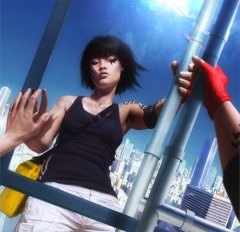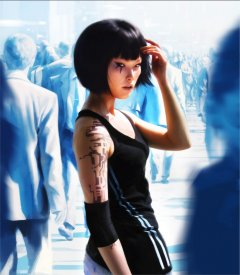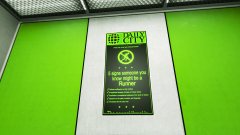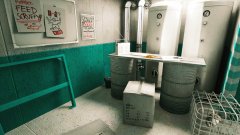Mirror's Edge
| Mirror's Edge | |
|---|---|
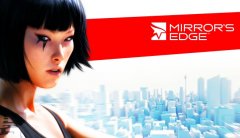 |
|
| Platforms | Windows, Xbox 360, PlayStation 3 |
| Genre | Dystopian first-person parkour |
| Buy from Amazon | |
Here we have Mirror's Edge, a first-person platformer of sorts, released in late 2008/early 2009 by DICE/EA. I've been interested in the game for a while, starting from its strong marketing campaign, so I jumped on the chance to play it recently.
It can be briefly summarized that in Mirror's Edge, you are a runner, tasked to transfer information between groups looking to avoid the surveillance of an overbearing government and its allies. As escaping capture is of utmost importance, runners do most of their travel on free outdoor environments, especially rooftops. Thus the gameplay is largely parkour-based, emphasizing proper use of momentum, speed and techniques to accomplish goals. At its best, this leads to a smooth, sublime experience, reminiscent of games like Jet Set Radio, Shadow of the Colossus, NiGHTS, and the original Prince of Persia. Mirror's Edge takes the player further into that experience, locking you to a first-person view with constant reminders of your physical struggles with and against the forces of gravity and objects in your world.
And unquestionably, it does a fantastic job doing so. If there was ever a game that would make you lean in your chair like a 5-year-old playing mario for the first time (Jump Mario, Jump!), this would be it. And the game starts you out fairly generously to learn the basics. To start, you have a "runner vision" sixth sense, which displays goal objects in red to make it clear where you should be heading next. We also get a hint button which, when pressed, directs your view towards the next major goal/object you need to reach. This hint button can range from extremely useful to useless, depending on where they decided to put the next pointer in the area. Seems like they could have walked through the levels testing it a bit better. The game also gives fairly frequent checkpoints, which you'll return to upon assumed incapacitation or death (be it from enemies or much more likely, falling). You will respawn a lot and as with the hint button, the spots also seem a bit inconsistent but these things could be hard to exact with this type of game. With more trials and testing, these guidance systems could work much better.
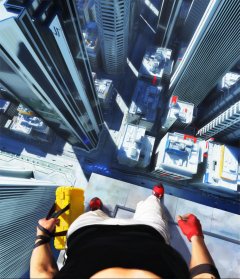 As implied earlier, the gameplay is largely the semi-guided semi-freeform parkour affair, where your goal is to get from point a to point b without falling to your doom. This is often complicated by the baddies, mostly consisting of generic law enforcement or members of private security firms intent on stopping you from reaching your goals. These encounters can either be avoided or engaged head on. Again, this is where a bit of frustration rises. Oftentimes it is hard to realize whether a fight is meant to be fought or avoided. Things seem more obvious later in the game, but early encounters can be confusing to new players. The story directs you to avoid fighting whenever possible. Our playable character, Faith, is slowed down by carrying weapons and cannot do much effective fighting outside of the bullet-time effect which allows her to readily perform counter attacks to quickly and efficiently disabilitate enemies. The effect, which you supposedly refill by running, seems pretty much useless outside of brief moments when you begin a close encounter with an enemy. All in all, fights just seem much easier by isolating one enemy, taking their gun, then using fps gameplay on the others. To me, this just didn't really feel like the intended method of fighting.
As implied earlier, the gameplay is largely the semi-guided semi-freeform parkour affair, where your goal is to get from point a to point b without falling to your doom. This is often complicated by the baddies, mostly consisting of generic law enforcement or members of private security firms intent on stopping you from reaching your goals. These encounters can either be avoided or engaged head on. Again, this is where a bit of frustration rises. Oftentimes it is hard to realize whether a fight is meant to be fought or avoided. Things seem more obvious later in the game, but early encounters can be confusing to new players. The story directs you to avoid fighting whenever possible. Our playable character, Faith, is slowed down by carrying weapons and cannot do much effective fighting outside of the bullet-time effect which allows her to readily perform counter attacks to quickly and efficiently disabilitate enemies. The effect, which you supposedly refill by running, seems pretty much useless outside of brief moments when you begin a close encounter with an enemy. All in all, fights just seem much easier by isolating one enemy, taking their gun, then using fps gameplay on the others. To me, this just didn't really feel like the intended method of fighting.
Mirror's Edge has a fairly typical but somewhat effective storyline. As you may have picked up already, you play Faith, a member in a group of runners who transfer information to clients using physical mediums. Faith and her twin policewoman sister Kate are left orphans, as both their parents died in front of them during a protest gone wrong. As the story starts, Kate is framed for a murder of a prominent, popular politician who had a genuine chance to change the city for the better. So not only do we find the city's hopes dashed for now, but you become intertwined in a plot to discover the facts behind the death of a politician and Kate's framing. This continues in a fairly traditional path, with a few twists that spice up the story but would surprise few people. The main game lasts less than 10 hours, with only ~6 logged on a initial file without any attempt of hurrying.
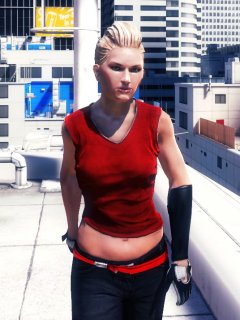 Despite the short length, the game paces fairly well and with the type of game, has a high mastering curve. The developers wisely include modes to prolonge/encourage repeat plays of the game, including timetrial, speedrun, and collecting modes. There is also an extra DLC timetrial pack available, with fully abstracted environments to endorse synthenasia. As you will be learning new tricks and momentum effects for quite some time, these modes will feel fresh long after the initial story and are great for encouraging continued play, especially if you know yourself as a player who could be drawn to play a fun engine for fastest times or high scores. Again, the initial length is short in this outing and would put off players looking for a lengthy main game, but you can find it for $20 or less at this point and the metagame can be extended as far as you wish to take it.
Despite the short length, the game paces fairly well and with the type of game, has a high mastering curve. The developers wisely include modes to prolonge/encourage repeat plays of the game, including timetrial, speedrun, and collecting modes. There is also an extra DLC timetrial pack available, with fully abstracted environments to endorse synthenasia. As you will be learning new tricks and momentum effects for quite some time, these modes will feel fresh long after the initial story and are great for encouraging continued play, especially if you know yourself as a player who could be drawn to play a fun engine for fastest times or high scores. Again, the initial length is short in this outing and would put off players looking for a lengthy main game, but you can find it for $20 or less at this point and the metagame can be extended as far as you wish to take it.
And personally, my favorite part of the game was its presentation. To start, it offers several art styles, each of which are done well. The marketing art, focused around Faith, is done in a pseudo-photorealistic style.
The in-game models are rendered in a very slightly semi-deformed style, somewhat reminiscent of an underrated gem from the past, Trickstyle.
Story cutscenes (such as the intro) are drawn purely cel shaded, albeit with somewhat uncommon animation (eg: Faith's shimmy-walking).
 And then of course, we have the minimalist yet superbly directed style of the environments in the main game. From the scores of detail-less buildings in the opening menu to its vibrant detail and the end, I was often reminded of technical feats created in the PC demo scene. And interestingly enough, DICE was founded by members of a demo group. Although their participation in that world far precedes the demos I related to the game style, the necessary programming aptitude and perhaps continued observation of current feats may have made a direct impact on the unique style of this game. Colors are distinct and remind you of both factions and openness; runners are symbolized by red and free will, authority as blue and oppression, and the city by neutral whites and yellows (perhaps the best color implementation I've seen since NiGHTS). Certain tints are completely absent from the game.
And then of course, we have the minimalist yet superbly directed style of the environments in the main game. From the scores of detail-less buildings in the opening menu to its vibrant detail and the end, I was often reminded of technical feats created in the PC demo scene. And interestingly enough, DICE was founded by members of a demo group. Although their participation in that world far precedes the demos I related to the game style, the necessary programming aptitude and perhaps continued observation of current feats may have made a direct impact on the unique style of this game. Colors are distinct and remind you of both factions and openness; runners are symbolized by red and free will, authority as blue and oppression, and the city by neutral whites and yellows (perhaps the best color implementation I've seen since NiGHTS). Certain tints are completely absent from the game.
The audio setup is equally impressive, featuring a strong openAL implementation with constant reminders and cues to the player's current status, momentum, and struggles. For example, as the player takes damage, both the sound and visuals shift as such, switching from bright to dull. Running speeds and drops are equally affected. And the falling sound is extremely brutal, so hopefully it will make you try extra hard not to fall throughout the game :P Background ambient tracks also fit in great, blending in to the situation without being overbearing. And its now-ever-so-customary vocal track seems much, much more pleasant and fitting than the average token licensed song. It feels so perfect that I wouldn't doubt if the underlying theme was also fit into background tracks at times and I just didn't notice (actually yeah, it is).
 And just in case you haven't been able to tell the theme of this article so far, it's a theme of huge potential but somewhat flawed implementation. The DICE team built all the parts for a masterpiece. Its first shot composed of diamond parts but a graphite whole. The presentation, technical aspects and unlockable system were great. What the upcoming sequel really needs is a significantly longer main game, somewhat longer extras, improved hint markers, more varied unlockables (I really think a third-person mode would be great upon completion of the main game) and a touchup on the gameplay/collision systems. These along with natural improvement can easily make a masterpiece. For example, we can look at a similar game, Jet Set Radio. The original was great and the sequel, Jet Set Radio Future kept all the great parts and completely redid the so-so parts to make a masterpiece. Mirror's Edge and JSR have somewhat similar styles and it's clear by comparison that Mirror's Edge could use similar treatment in story, longevity, gameplay frustrations and use of characters. Perhaps they could even port the physx calls to a global hardware physics engine since it looked so stunning in those previews ;)
And just in case you haven't been able to tell the theme of this article so far, it's a theme of huge potential but somewhat flawed implementation. The DICE team built all the parts for a masterpiece. Its first shot composed of diamond parts but a graphite whole. The presentation, technical aspects and unlockable system were great. What the upcoming sequel really needs is a significantly longer main game, somewhat longer extras, improved hint markers, more varied unlockables (I really think a third-person mode would be great upon completion of the main game) and a touchup on the gameplay/collision systems. These along with natural improvement can easily make a masterpiece. For example, we can look at a similar game, Jet Set Radio. The original was great and the sequel, Jet Set Radio Future kept all the great parts and completely redid the so-so parts to make a masterpiece. Mirror's Edge and JSR have somewhat similar styles and it's clear by comparison that Mirror's Edge could use similar treatment in story, longevity, gameplay frustrations and use of characters. Perhaps they could even port the physx calls to a global hardware physics engine since it looked so stunning in those previews ;)
I loved the style and feel of the game and the potential is certainly there. As such, I'll strongly recommend at least a demo play as we'll be looking forward to the sequel. Hopefully they'll have enough time, resources and continued creativity to move it forward, because
Running is what I do best

